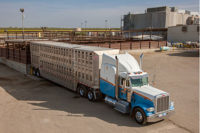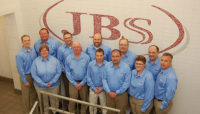Kill Floor Improvements
By Sam Gazdziak, Senior Editor
Automation on the poultry kill and eviscerating lines is increasing efficiency and product quality.
The kill and evisceration floors of a poultry processor are in a state of evolution. Equipment and automation systems are changing the amount and types of manual labor that is needed in this section of the plant. On top of that, processors are under increased scrutiny to ensure that the birds are treated humanely in their last moments. The dual needs of employee safety and animal safety are forcing companies to re-evaluate their processes and systems on the kill floor, and new technology is being developed to assist those companies.
Several aspects of the poultry kill floor have been completely or largely automated, thanks to improved technology. According to Stork Food Systems, unloading live birds by hand has been replaced by automated unloading equipment. Furthermore, the use of stunners (electric and gas) and killers has automated the exsanguination step that was performed manually, and controlled-atmosphere stunning (CAS) has made the shackling process easier, as the birds are unconscious.
This area of the process is critical to get proper results further downstream. “The most critical aspect during bird handling, stunning, killing and bleeding is that the animal is still alive,” says a Stork spokesman. “Therefore inadequate handling of the birds or equipment errors will result in hemorrhages and broken bones, with the final effect of increasing downgrades and reducing saleable yield.”
Technology and automation has improved the evisceration work as well. Meyn America has introduced several time- and labor-saving pieces, such as the Auto Transfer Machine, which replaces manual hangars, and the Maestro high-speed evisceration line, which replaces draw hands and pack pullers.
“The Auto Transfer Machine eliminates birds piling up on the rehang table, and the Maestro reduces the amount of bird contamination,” says Heath Jarrett, vice president of sales and projects. “This reduction in bird contamination results in a significantly reduced number of birds going to salvage and washout.”
Stunning advancements
One of the biggest recent developments in kill floor automation has been the use of controlled atmosphere stunning for poultry.
“During normal processing conditions, a significant amount of carcass damage is caused by live bird shackling, excessive bird activity (wing flapping) from hanging to stunning, pre-stun electric shocks (water overflowing from the in-feed of the electrical stunners) and death struggle during bleeding (birds not properly stunned or recovering consciousness before death).”
In some applications, a CAS system can help to reduce some types of carcass damage. Studies, mostly from Europe, have reported carcass and meat-quality benefits from using CAS compared to high-current stunning, Stork reports.
There are employee benefits to using the system as well, the company notes. As the birds are not conscious, there is less dust and bird opposition in the live hanging room, as well as normal light conditions and less noise.
The CAS method can be used in one of two ways. It can be applied to the crated birds, or the birds can be unloaded and belt-conveyed through a gas cabinet. Different gases can be used, such as argon, nitrogen and carbon dioxide, and the type of gas and concentration can have a substantial effect on meat quality. The improper gas mixture or a poorly designed system can negatively affect the poultry meat yield and quality.
Stork’s system was designed to focus on animal welfare and carcass and meat quality, the companyrepresentative says. In the two-stage system, the bird is first introduced to an anesthetic atmosphere with relatively low carbon dioxide content and increased oxygen content. In the second stage, the gas levels are switched to high carbon dioxide and low oxygen atmosphere. This combination results in irreversible unconsciousness. The gas mixture is continuously controlled and monitored.
An alternative to CAS is electrical stunning, either high- or low-current or high- or low-frequency. Low-frequency stunning has comparable meat tenderness and cook yield with CAS systems. Stork says that low-current (less than 40 milliamps per bird) and high-frequency (greater than 300 Hz) stunning is typically used in the United States.
Technological innovations
As each processor in the industry is different, there is not a single machine or system that can improve every company’s output and productivity. A company must look at its own operations to determine what the best solution is for it.
Jarrett says, “There are several factors that processors must consider, most importantly bird size, line speeds — current and future — labor savings and water usage savings.”
Meyn America has recently introduced the Meyn Circlean, an inside/outside bird washer. It has a two-stage cleaning process. Rotating brushes gently enter the cavity and pass through twice to loosen dirt from the surface of the bird. At the same time, water sprayed from the brush units flushes the dirt away, including from under the leaf fat and abdominal skin. The bird passes through two sets of nozzles on the breast and back spraying at mid-pressure and a final rinse at normal pressure to remove dirt. Placed at the end of the evisceration line, it can reduce the amount of visible contamination on the bird and helps to eliminate cross-contamination of other product, he adds. Using recommended pressures and normal line speeds, water usage is 0.8 liters per carcass.
Investing in new equipment or systems at the front of the production process will result in changes to the rest of the process, and processors will have to keep that in mind. Stork says that a company must keep in mind its production rate and if the equipment has been designed to support that production rate. Along with the quality and yield, a company must consider the potential negative effects on downstream operations performance, as well as service and support from the supplier, cost of ownership and the initial investment.
The right equipment design is important for proper performance, naturally. In the case of CAS systems, the company notes that some systems with a single-stage setup can cause strong bird convulsions, sufficient to cause a quality downgrade. Other systems that do not have precise atmosphere control can lead to inconsistent results.


Report Abusive Comment